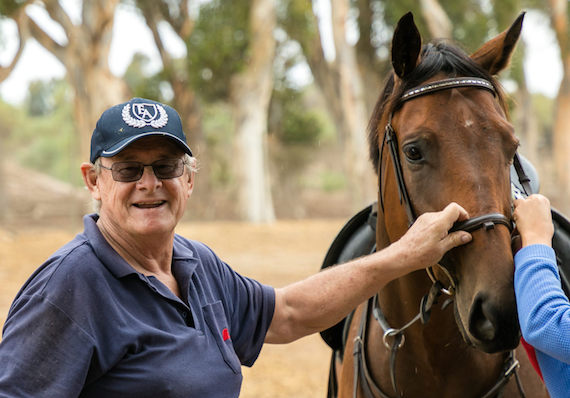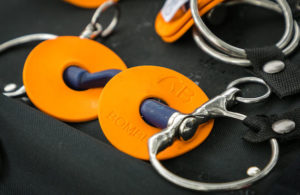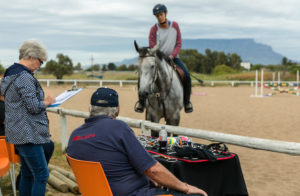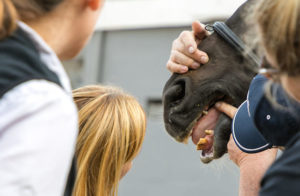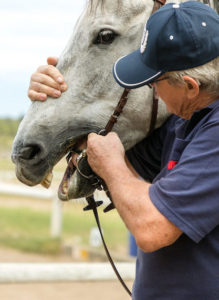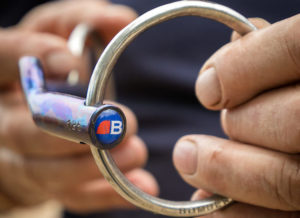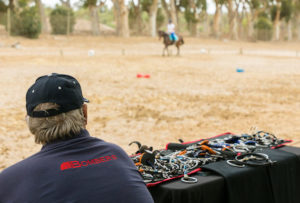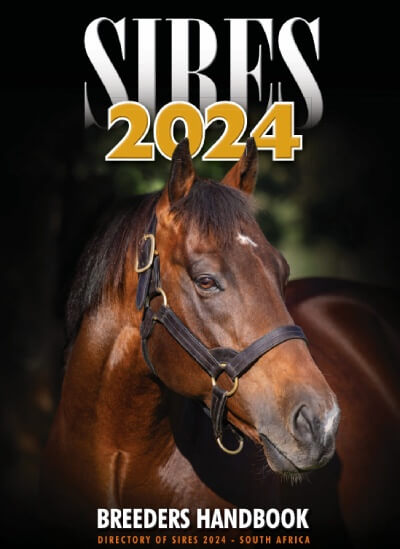They say there are courses for horses and bits seem to work the same way. Someone who knows more about this than most is Pete ‘Bomber’ Nel, who has been in the business of making bits for over 30 years. He recently hit racing headlines by assisting the Mike and Adam Azzie yard with Hat Puntano and also settled a particularly sensitive filly for Duncan McKenzie.
Duncan’s filly is called Strawberry Girl. “She’s got lots of ability, but she’s an absolute terror – she just lifts her head and runs blind. We tried everything – even a nathe – and she didn’t want to know. If you started putting nosebands on, she’d just fight,” he explains.
Having worked with Bomber bits during his time with Dean Maroun as well as while working with Wendy Whitehead in Summerveld, Duncan saw Bomber’s interview with James Goodman on Winning Ways. “I listened to what he was saying about a horse’s bars and tongue and the bit he’d designed for Hat Puntano and thought ‘I need one like that!’
With the filly accepted to run over 1200m on 28 February, there wasn’t much time. “I knew if we couldn’t get her to settle, she wouldn’t make it, so I rang Bomber. I had to measure the teeth, the jaw and all these things and send the information through. They did an assessment and recommended a bit (coincidentally, a DC Morgan, the same one as Hat Puntano), sent it off by courier and it arrived at 11am the next day. They were very efficient and Bomber kept ringing to check whether I’d received it.”
The bit arrived at 11am on Thursday morning, so I only got to work her in it on Thursday afternoon. We gave her a little time to get used to it and then took her for a canter and Teaque (Gould) couldn’t believe she was such a different horse.” Strawberry Girl went to post the following day as scheduled and to quote Duncan, ‘shat in’ by 2.75 lengths.
When I heard that Bomber was coming to Cape Town for a bit fitting weekend, I made sure I tagged along.
Meeting Bomber
Friday’s session was a chance to meet Bomber and his wife Trish, to listen to Bomber’s philosophies on bitting, his findings from his years of experience and, of course, to see his work first hand.
Bomber is immediately warm and likeable. With something of the air of an eccentric professor about him, his enthusiasm for his craft is matched only by his kindness and patience in explaining it to others and it was a thoroughly enlightening evening.
Bomber’s philosophy is a fairly simple one and is based on the premise that Pressure = Resistance and Resistance = Lack Of Control. Horses are flight animals and naturally resist confrontation, so their instinctive response to a threat is to run away or try and avoid it if possible. This is expressed by resistance or avoidance of some form (opening the mouth, coming above or behind the bit, sucking back the tongue, etc) which in turn results in a lack of control. Where most people attempt to solve the problem by adding nosebands or trying more severe bits’, Bomber’s approach is to relieve the pressure, resulting in a more comfortable and cooperative horse.
Where to start
Bomber recommends always assessing a new horse from scratch. In the same way that one would check the teeth, back and saddle fit, he recommends taking a good look at the horse’s mouth before accepting that the current bit really is the best fit.
It was interesting to hear Bomber say that in his 30 years in the business, he has seen horses’ jaws – and their lower jaws in particular, become markedly narrower, meaning that more often than not, we are using bits that are too big.
He has also noticed mouths getting smaller and the length of what he refers to as the ‘smile’ becoming shorter, while lips and tongues are becoming more fleshy.
“Remember that the mouth is the most sensitive part of a horse. Having an ill-fitting or uncomfortable bit is like having a stone in your shoe. But in their case, they can’t remove it.” If a horse feels discomfort, it may try to suck back its tongue or open its mouth to try and avoid the pressure. The traditional solutions are either to strap the tongue down with a tongue tie or close the mouth with a noseband, which may end up compounding the problem.
Because of a complex relationship of muscle attachments, a horse can only stride as far as its nose can reach, making it vital that they are using their heads and necks freely.
Bomber confides, “Mike de Kock once said to me ‘At my level there is 2% difference between walking to the winner’s enclosure or walking back to the stable. If I can get 0.5% from feed, another 0.5% from training, 0.5% from the vet, dentist and physio then if you give me your 0.5%, I’ve got 2%.’”
Bomber hypothesises that sucking back of the tongue may even have an impact on bleeding. But either way, it is certain that discomfort affects performance. In a sport where millimetres can separate a winner from an also ran, getting it right is well worth the effort and Bomber insists that getting the right bit can make a dramatic difference. “When you remove the pressure, the change is immediate,” he enthuses. “And when you see that, you get goosebumps!”
How it works
A bit can act in four main places – on the tongue, on the bars of the jaw, the roof of the mouth (depending on the mouthpiece) and some also exert poll pressure. One also needs to take into consideration the correct size of the horse’s mouth, the spacing of the teeth (particularly the canines in entires and geldings), the fleshiness of the lips, the size of the tongue, the shape of the palate and the shape of the horses’ bars.
Fitting
Most opt for a thick bit on the assumption that it is the kindest option, but when one considers that it has to compete for real estate with the teeth, tongue and cheeks – which are now all compressed into a smaller area – things start to look a little different.
“Every horse is different, so first you have to identify where the horse doesn’t want pressure. Then you have to remove the pressure or alternatively, distribute it over a larger surface area.”
It has been Bomber’s life’s work to find ways to remove or redistribute pressure. Bomber’s ‘Happy Tongue’, is a ported mullen mouth snaffle with an ergonomically shaped port to relieve tongue pressure. For shorter-mouthed horses, it is a traditional horizontal design, whereas for horses with slightly longer mouths (or in order to accommodate canine teeth), there is an angled option, but whether it is a snaffle for a dressage horse, a Pelham for an Icelandic pony or anything in between, the aim is always comfort first and to redistribute as much pressure as possible.
As the bars differ widely from horse to horse – and some horses may even have mismatched bars – Bomber has started taking moulds of horses’ mouths, enabling him to get a better understanding of the shape of the bars, further helping to refine the process.
With horses’ mouths getting smaller, ascertaining the correct bit size and thickness is important. The general trend is to use something that is too wide, resulting in it sliding around inside the horse’s mouth as well as applying pressure unevenly. Bomber is also a proponent of using a bit strap to help stabilise each bit.
He uses a variety of materials, from his trademark blue tinted sweet iron, to his newly launched feather-light Titanium range, and each Bomber original is stamped with the size of the bit as well as the brand name on the left hand side of the bit.
There is a wide range of mouth pieces, cheek pieces, thicknesses as well as solid, single or double jointed options. Bomber even has cable bits and, as no two mouths are alike, prefers to modify and custom design bits for each specific horse. With every bit hand made at Bomber’s KZN factory, he can finesse each aspect to ensure something that fits perfectly. Best of all, being locally made, they are all Proudly South African.
Bomber takes care to ensure his designs are approved by the NHA and he also has as many as possible approved for competition by the FEI.
Consultations
During the bitting consultations, each horse was assessed under saddle in its current bit. Then Bomber took the bit out, examined the horse’s mouth from scratch and more often than not, recommended a different bit to try. Being able to watch from the sidelines was fascinating. In every case but one, there was a markedly different reaction from each horse to the different bits and Bomber’s relentless attention to detail and to finessing and fine tuning just the right solution for each horse was phenomenal.
Bomber, who incidentally turns 70 later this year, spent the entire day on his feet, as did Trish who patiently took notes and comments for the files. His energy was formidable and his enthusiasm infectious.
I rushed home to poke around inside my own horses’ mouths and my discoveries left plenty of food for thought as well as room for improvement, but as per the old saying, once you know better, you do better. I’ve filled out a couple of assessment sheets and am looking forward to seeing what Bomber and the team come up with.
Here’s hoping for goosebumps!


